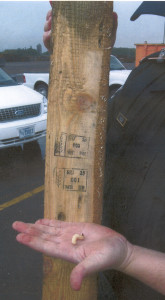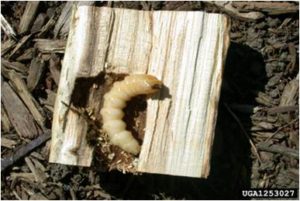ALB pupa; Thomas B. Denholm, New Jersey Department of Agriculture; bugwood.org
As I have noted in earlier fact sheets and blogs, wood packaging (crates, pallets, etc.) has been a major pathway for introductions of highly damaging wood-boring pests since at least the early 1990s. (See Figure 2a in Aukema et al. 2010; reference given at end of blog.)
This rise in introductions followed the rapid increase in use of shipping containers – as described in Levinson’s book The Box (reference below). Levinson notes that shipping capacity increase fourfold during the decade of the 1970s, reaching 10 million tons in 1980. (See also my blog from August 2015 here). A second factor was the U.S. opening trade with China in 1979. Since in those years – before establishment of more sophisticated detection tools – a pest was often present for close to a decade before being detected, it is not surprising that detections of woodboring pests began their rise around 1990.
February 2017 marks 11 years since the international standard (ISPM#15) was put into effect by the United States and 17 years after the U.S. and Canada began requiring China to treat its wood packaging. Nevertheless, numerous shipments containing wood packaging that does not comply with the regulations continue to arrive at our borders – and to bring pests.
A study by scientists and economists (Haack et al. 2014; reference below) analyzed detection data from the U.S. and other countries in order to calculate the reduction in pest risk associated with wood packaging following adoption of ISPM#15. They concluded that one tenth of one percent of the wood packaging entering the U.S. after adoption of ISPM#15 still contained a tree-killing pest. This sounds like a small risk. However, the U.S. imported approximately 25 million shipping containers in 2013 – and presumably similar numbers in more recent years. It has been estimated in the past that wood packaging is used in just over half of these containers. Therefore, even if merely 1/10th of 1% of the wood packaging in these shipments contained a tree-killing pest, 13,000 containers harboring pests probably enter the country each year. That is 35 potential pest arrivals each day.
Interception records compiled by USDA APHIS and the DHS Bureau of Customs and Border Protection clearly show that wood packaging infested with pests continued to arrive in recent years – including in 2016.
Over a period of seven years – Fiscal Years 2010 through 2016 – CBP detected more than 20,700 shipments with wood packaging that did not comply with ISPM#15. While most of the non-compliances represented wood packaging that lacked the required mark showing treatment per ISPM#15, in nearly 5,000 cases the wood packaging actually harbored a pest in a regulated taxonomic group (see Customs presentation at the Continental Dialogue here).
Customs inspectors at 11 ports (listed at end of blog) have been sending intercepted wood packaging containing insect larvae to APHIS for study. APHIS has also sent to me its record of interceptions for the period FYs 2011 – 2016.
The APHIS interception database contained 2,547 records for insect detections. The insects belonged to more than 20 families. Families with the highest numbers of detections were Cerambycids – 25% of total; Curculionidae – 23% (includes Dendroctonus, Ips, Orthotomicus, Scolytinae, Xyleborus, Euwallacea); Scolytidae – 17% (includes true weevils such as elm bark beetles); Buprestids – 11%; and Bostrichidae – 3%. Not all of the insects in these groups pose a threat to North American plant species.

The samples sent by CBP to APHIS are limited largely to the families Cerambycidae (the family containing the Asian longhorned beetle) and Buprestidae (the family containing the emerald ash borer). This dataset contains 1,068 insects, obtained over the period April 2012 through August 2016 from 786 separate interceptions of non-compliant wood packaging. The sample is not from a random set of ports – four of the seven entry points are on the Mexican border, and the proportion was even higher in the early years of the study.
The APHIS interception database reports pests detected in wood packaging from dozens of countries. The countries of origin with the highest numbers of shipments detected to have pests present were Mexico, China, Italy, and Costa Rica. These numbers reflect in part import volumes. The U.S. imports huge volumes of goods from both Mexico and China. (Our second largest trade partner is Canada; the U.S. and Canada have exempted wood packaging moving between the two countries from the requirement that it comply with ISPM#15. Neither country inspects wood packaging from the other country at even the low rate of inspection applied to wood packaging coming from Mexico or overseas.)
The CBP-APHIS database includes pests found in wood packaging from 39 countries, including 212 shipments from Europe; 130 shipments from Asia; and 341 shipments from the Americas – almost exclusively Mexico.
APHIS analysts point out that the pests from Mexico might pose a lower risk since some proportion of them are probably species shared between our two countries. (However, several woodborers from Mexico are killing trees in the U.S. – e.g., goldspotted oak borer, walnut twig beetle, and soapberry borer. These species are described briefly here. These insects were probably introduced to vulnerable parts of the U.S. in firewood rather than wood packaging.)
As always (see the briefs here as well as various articles by Haack and Cavey), imports of heavy objects are associated with wood packaging found to be infested with insects: metal and machine parts, tiles, decorative stone. Imports of fruits and vegetables rank high because of the large number of interceptions in wood packaging from Mexico.
Comparing the estimate by Haack et al. 2014 with the CBP data indicates that Customs is detecting about 6% of all pest-infested shipments. I do not believe that increasing the inspection workforce and effort will result in substantial improvement in this rate.
On average, 26% of infested wood pieces detected by CBP were found in wood that had been treated according to ISPM#15 requirements (if we believe the ISPM#15 stamp on the wood). Does this indicate fraud? Or is the problem accidental misapplication of the treatments? Or are the treatments less effective than hoped? APHIS researchers have found that larvae from wood subject to methyl bromide fumigation were more likely to survive to adulthood than those intercepted in wood that had been heat treated. Does this indicate that methyl bromide fumigation is a less effective treatment?
CBP staff reported that only about 30 import shipments (out of nearly 21,000 shipments found to be in violation of ISPM#15 requirements) have received a financial penalty. CBP staff cite two reasons for the low penalty rate:
- USDA policy requires that an importer be caught 5 times in a year with non-compliant wood packaging before authorizing a fine; and
- APHIS has not designated SWPM as a high-risk commodity
What Can Be Done to Slow or Eliminate this Pathway?
Our goal should be to hold foreign suppliers responsible for complying with ISPM#15. One approach is to penalize violators. APHIS and Customs might
- Prohibit imports in packaging made from solid wood (boards, 4 x 4s, etc.) from foreign suppliers which have a record of repeated violations over the 11 years ISPM#15 has been in effect (17 years for exporters from Hong Kong & mainland China). Officials should allow continued imports from those same suppliers as long as they are contained in packaging made from other types of materials, including plastic, metals, fiberboards …
- Fine an importer for each new shipment found to be out of compliance with ISPM#15 in cases when the foreign supplier of that shipment has a record of repeated violations.
There would need to be a severe penalty to deter foreign suppliers from simply changing their names or taking other steps to escape being associated with their violation record.
At the same time, the agencies should work with NGOs and importers to promote creation of an industry certification program that would recognize and reward importers who have voluntarily undertaken actions aimed at voluntarily exceeding ISPM#15 requirements so as to provide a higher level of protection against invasive species that would otherwise potentially be introduced into the United States.
What You Can Do
- Tell your member of Congress and Senators that you are worried that our trees are still being put at risk by insects arriving in wood packaging. Ask them to urge the new Secretary of Agriculture (Sonny Perdue, former governor of Georgia) to take the actions outlined above in order to curtail introductions of additional tree-killing pests.
- Talk to your friends and neighbors & civic organizations about the threat to our trees. Ask them to join you in communicating these concerns to their Congressional representatives and Senators.
- Write letters to the editors of your local newspaper or TV news station.
Use your knowledge about pests threatening trees in your state or locality in your communications!
Ports that have sent specimens to APHIS lab: Seattle, Long Beach, San Diego, Laredo, Hildago, Houston, Miami, Port Everglades, Chicago, Detroit
References
Aukema, J.E., D.G. McCullough, B. Von Holle, A.M. Liebhold, K. Britton, & S.J. Frankel. 2010. Historical Accumulation of Nonindigenous Forest Pests in the Continental United States. Bioscience. December 2010 / Vol. 60 No. 11
Haack, R. A., K. O. Britton, E. G. Brockerhoff, J. F. Cavey, L. J. Garrett, M. Kimberley, F. Lowenstein, A. Nuding, L. J. Olson, J. Turner, and K. N. Vasilaky. 2014. Effectiveness of the international phytosanitary standard ISPM no. 15 on reducing wood borer infestation rates in wood packaging material entering the United States. Plos One 9:e96611.
Levinson, M. The Box: How the Shipping Container Made the World Smaller and the World Economy Bigger Princeton University Press 2008
We welcome comments that supplement or correct factual information, suggest new approaches, or promote thoughtful consideration. We post comments that disagree with us — but not those we judge to be not civil or inflammatory.
Posted by Faith Campbell

I had no idea what ISPM15 was until I was talking to a friend who works a lot in shipping. He was complaining about infested wood from china because the wood hand’t been treated properly. I think it’s really important that these tree killing pests are kept away as much as possible. Thanks for helping teach me about ISPM15!
Your appeal for Processed Wood packaging is faulty. Emissions from solvents used in glues are toxic for people working in warehouses.
Unfortunately the emissions linger for months.
Proper treatment and recycling is the way.
Best regards
Michiel ten Haaf
Netherlands